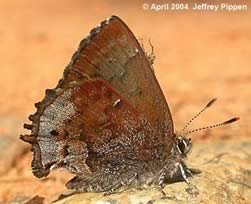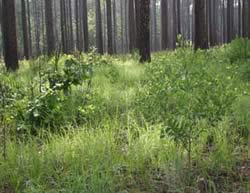
National Fire Plan Success Story
Multiple Benefits of Prescribed Burning
National Forests in Texas
2008

Frosted Elfin (Callophrys irus).

The frosted elfin's host plant, little tree indigo (Baptisia nuttalliana).
Prescribed burning has long been recognized as an important tool in reducing hazardous fuels, improving wildlife habitat, controlling competing vegetation and restoring natural communities and ecosystems. In recent years, the National Forests in Texas have been implementing an aggressive program of prescribed burning in order to restore the forests to a Fire Regime Condition Class 1, where vegetation and fuel conditions are characteristic of the natural fire-adapted ecosystems. Specific objectives have targeted habitat enhancement for the endangered red-cockaded woodpecker (RCW) and to address hazardous fuels in the aftermath of Hurricane Rita.
As burned acres have increased, the impact on RCW habitat and population dynamics has been exceptional with steady increases in breeding populations for both the Angelina and Sabine National Forests in Texas.
The benefits of prescribed burning have also been recently observed for a lesser known species of these fire adapted ecosystems in Texas. David Henderson, of the North American Butterfly Association has reported the occurrence of the rare Frosted Elfin (Callophrys irus) in the Moore Plantation Wildlife Management Area on the Sabine National Forest.
This species, which is quite rare throughout its range in the eastern U.S., depends on frequently burned, sandy pine areas with plenty of its host plant, Baptisia nuttalliana (Little Tree Indigo). The survey reported 9 adults, 3 eggs and 6 1st instar caterpillars. The habitat was reported to be excellent with the host plant common throughout the burned area.
Prescribed burning on the Sabine and other National Forests in Texas is accomplished through hazardous fuels, Knutsen-Vandenburg collections and wildlife cooperative funding in partnership with Texas Parks and Wildlife Department and the National Wild Turkey Federation.
Contact: Ira McWhorter, Fire Ecologist, (936) 897-1068 or imcwhorter@fs.fed.us.